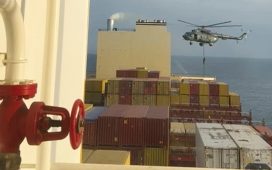The head of Boeing has admitted the company made communications errors in its dealings with regulators and airlines in the wake of the 737 Max jet crisis that grounded the entire fleet.
Speaking on the eve of the Paris air show, the Boeing chief executive, Dennis Muilenburg, said the company’s communications were “not consistent” and that was “unacceptable”. Muilenburg added that the US aerospace group had failed to communicate “crisply” with regulators and carriers about the plane.
The 737 Max was grounded globally in the aftermath of an Ethiopian Airlines crash outside Addis Ababa in March that killed all 157 people on board. It was the 737 Max’s second disaster in five months, after 189 people were killed on a Lion Air flight in Indonesia in October.
Asked how the design and constructions of the 737 Max failed to capture apparent flaws in the software and sensors behind the airplane, Muilenburg said: “Clearly, we can make improvements, and we understand that and we will make those improvements.”
Investigations into the Ethiopia and Indonesia accidents have centred on the Manoeuvring Characteristics Augmentation System (MCAS), which was designed to keep the aircraft stable in flight. An investigation into the Ethiopia crash has reportedly found that the MCAS software – which automatically pushes the aircraft’s nose down to guard against a loss of lift – was activated by erroneous “angle of attack” data from a single sensor, forcing the pilots into a doomed struggle to control the aircraft.
Muilenburg added: “When I make comments about the previous design and how we followed those processes, that’s something we put a lot of thought and depth of analysis into. That doesn’t mean that it can’t be improved.”
The Boeing boss, who has been under fire over the 737 MAX design and Boeing’s handling of the crisis, said he expected the plane to return to service this year.
Muilenburg said he was “disappointed” the company wasn’t more forthcoming with information when engineers in 2017 learned that cockpit alerts intended to warn pilots about certain sensor malfunctions didn’t work or weren’t operating as intended due to a software error. The company previously said senior Boeing leaders didn’t learn about the issue until after the second crash.
Lion Air crash
Lion Air flight JT610 crashes after making a sudden, sharp dive into the Java Sea 13 minutes after departing from Jakarta, Indonesia. All 189 people onboard are killed. That particular plane had been in use for less than three months.
Boeing’s new advice
Boeing issues revised instructions on how pilots should react to erroneous readings from “angle of attack” sensors, believed to be a key factor in the Lion Air crash.
Lion Air crash report
“In our view, the plane was not airworthy,” is the interim finding of the official investigation into the crash. The Indonesian transport safety agency did not pinpoint a definitive cause of the accident, but said Lion Air kept putting the plane back into service despite repeatedly failing to fix a problem with the airspeed indicator.
Ethiopia Airlines crash
Flight ET302 crashes approximately six minutes after taking off from the Ethiopian capital, Addis Ababa, killing all 157 people onboard. The captain had reported difficulties, and flight radar data shows the aircraft was climbing erratically with an unstable vertical airspeed.
Boeing grounds fleet
Canada and the US become the latest nations to ground the Boeing 737 Max. Boeing itself issues a statement saying it “continues to have full confidence in the safety of the 737 Max”, but that “out of an abundance of caution and in order to reassure the flying public” it is recommending the grounding of the entire global fleet of 371 aircraft.
Interim report findings
The interim report into the Ethiopian Airlines crash finds that the pilots correctly followed Boeing’s emergency instructions, but were still unable to stop the plane’s nose repeatedly pointing down. The jet hit an airspeed of 500 knots (575mph), well above its operational limits, before cockpit data recordings stopped.
The US Federal Aviation Administration (FAA) has faulted Boeing for not telling regulators for more than year that a safety indicator in the Max cockpit didn’t work. Pilots are angry that the company didn’t tell them about the MCAS system.
Boeing has been working round the clock on a fix to allay safety concerns, and it is likely to remain out of service until August at the earliest, which is well into peak season for many airlines. American Airlines, a major US customer of the aircraft, has pushed its cancellations of 737 Max services into September.
Reuters has reported that the FAA has tentative plans to begin test flights of proposed software fixes, possibly as early as this week.
The long-anticipated certification tests, which will take several weeks to complete, have been planned with the support of European and Canadian regulators, its source reported.
The 737 Max disasters have ignited tensions between air regulators on either side of the Atlantic, amid concerns over the FAA’s relationship with Boeing, including the degree of self-certification.
Ethiopia chose to send the data recorders from the crash to safety investigators in Paris, and the European Union Aviation Safety Agency has indicated it would carry out its own assessment of the fix, rather than rely on the FAA in America.
On Sunday, the Observer reported that pilots have also voiced fears over the safety of Boeing Dreamliners after a crucial fire-fighting system has been found to have the potential to malfunction.
Boeing has issued an alert to airlines using its flagship B787 Dreamliner, warning that the switch used to extinguish an engine fire has failed in a “small number” of instances. The switch also severs the fuel supply and the hydraulic fluid to prevent flames spreading.
In its alert to airlines, Boeing warns that long-term heating can cause the fire switch to stick in the locked position so it can’t be used to release the two fire extinguishers in each engine.
UK airlines Tui, British Airways and Virgin Atlantic operate more than 60 Dreamliners between them. The FAA has decided not to ground the fleet, despite admitting a “risk to the flying public”.













